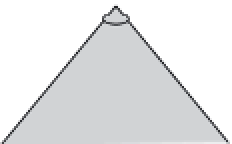Biomedical Engineering Reference
In-Depth Information
FIGURE 9.11
Arrangements of sensors for intensity-based horizon stabilization. The configuration on the left is ideal
but impractical in most aircraft due to the separation between nose and tail. The configuration on the right is convenient,
at the cost of less definitive control over pitch.
Since insects do not have rear-looking ocelli,
it can be assumed that the pitch reflexes caused
by the median ocellus are referenced to the light-
level information sensed by the two lateral sen-
sors or the compound eyes. The solution of
using overall light levels as a reference in the
pitch axis is less reliable than the differential
response on the roll axis. It appears that dragon-
flies have evolved higher-order processing in
the median ocelli, including a selective response
to the rate of pitch axis rotation
[32]
, analogous
to a rate gyroscope.
Right
Lateral View
Left
Lateral View
9.4.1 Sensor Signal Processing
FIGURE 9.12
The opposed sensors detect an imbalance
in light levels. To correct the attitude error, the aircraft-
control surfaces must rotate the craft away from the dark
side. The equilibrium position resulting from following this
simple rule is level wings.
Embedded hardware was constructed to test
the concept developed in theory and simula-
tion. The resulting device is shown in
Figure
9.13
. The ultraviolet channel used silicon-car-
bide diodes with integral ultraviolet-pass filter.
The green channel used silicon diodes with an
interference filter of bandwidth 100 nm cen-
tered at 550 nm.
lateral- and longitudinal-looking sensors would
allow full stabilization of attitude in pitch and roll
(in an ideal environment).




















































